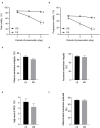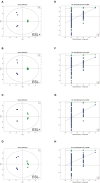Metabolomic analysis reveals spermatozoa and seminal plasma differences between Duroc and Liang guang Small-spotted pig
- PMID: 36686181
- PMCID: PMC9853278
- DOI: 10.3389/fvets.2022.1078928
Metabolomic analysis reveals spermatozoa and seminal plasma differences between Duroc and Liang guang Small-spotted pig
Abstract
The Liang guang Small-spotted pig is a well-known Chinese indigenous pig that is valued for its exceptional meat quality. However, the Liang guang Small-spotted pig has a lower semen storage capacity, shorter storage time and worse semen quality compared to Duroc. Pig sperm used for artificial insemination (AI) loses part of vitality and quality when being stored in commercial solutions. Serious vitality losses and short shelf life of the semen are particularly prominent in Liang guang Small-spotted pig. In this study, the metabolites in seminal plasma and spermatozoa of Duroc and Liang guang Small-spotted pigs were identified using UHPLC-Q-TOF/MS technology. The findings indicated forty distinct metabolites concentrating on energy metabolic substrates and antioxidant capacity in Liang guang Small-spotted pig and Duroc seminal plasma, including D-Fructose, succinate, 2-dehydro-3-deoxy-d-gluconate, alanine betaine, citrate, carnitine, acetylcarnitine and so on. Seventeen different metabolites were explored, with a focus on glycerophospholipid metabolism in Liang guang Small-spotted pig and Duroc spermatozoa, primarily including glycerol 3-phosphate, acetylcarnitine, phosphatidylcholine (PC) 16:0/16:0, palmitoyl sphingomyelin, acetylcholine, choline, glycerophosphocholine, betaine, L-carnitine, creatinine and others. This study reveals the metabolite profile of spermatozoa and seminal plasma among different pig breeds and might be valuable for understanding the mechanisms that lead to sperm storage capacity. Metabolites involved in energy metabolism, antioxidant capacity and glycerophospholipid metabolism might be key to the poor sperm storage capacity in Liang guang Small-spotted pig.
Keywords: Liang guang small-spotted pig; boar; metabolomic; seminal plasma; spermatozoa.
Copyright © 2023 Li, Sun, Li, Qin, Sun, Zeng, El-Ashram and Zhao.
Conflict of interest statement
JQ was employed by Guangxi Yangxiang Co., Ltd. JZ was employed by Guangdong YIHAO Food Co., Ltd. The remaining authors declare that the research was conducted in the absence of any commercial or financial relationships that could be construed as a potential conflict of interest.
Figures






Similar articles
-
Editing the cystine knot motif of MSTN enhances muscle development of Liang Guang Small Spotted pigs.Yi Chuan. 2021 Mar 16;43(3):261-270. doi: 10.16288/j.yczz.20-222. Yi Chuan. 2021. PMID: 33724210
-
Disruption of the ZBED6 binding site in intron 3 of IGF2 by CRISPR/Cas9 leads to enhanced muscle development in Liang Guang Small Spotted pigs.Transgenic Res. 2019 Feb;28(1):141-150. doi: 10.1007/s11248-018-0107-9. Epub 2018 Nov 28. Transgenic Res. 2019. PMID: 30488155
-
Single-base editing in IGF2 improves meat production and intramuscular fat deposition in Liang Guang Small Spotted pigs.J Anim Sci Biotechnol. 2023 Nov 2;14(1):141. doi: 10.1186/s40104-023-00930-4. J Anim Sci Biotechnol. 2023. PMID: 37919760 Free PMC article.
-
Potential of seminal plasma to improve the fertility of frozen-thawed boar spermatozoa.Theriogenology. 2019 Oct 1;137:36-42. doi: 10.1016/j.theriogenology.2019.05.035. Epub 2019 May 31. Theriogenology. 2019. PMID: 31200934 Review.
-
The role of seminal plasma in the liquid storage of spermatozoa.Anim Reprod Sci. 2020 Sep;220:106290. doi: 10.1016/j.anireprosci.2020.106290. Epub 2020 Jan 24. Anim Reprod Sci. 2020. PMID: 32001046 Review.
Cited by
-
Differential Metabolomic Signatures in Boar Sperm with Varying Liquid Preservation Capacities at 17 °C.Animals (Basel). 2025 Jul 22;15(15):2163. doi: 10.3390/ani15152163. Animals (Basel). 2025. PMID: 40804953 Free PMC article.
-
Liquid chromatograph-mass spectrometry metabolomics uncovers potential biomarkers of semen cryo-injury in goats.Anim Biosci. 2025 Apr;38(4):629-640. doi: 10.5713/ab.24.0435. Epub 2024 Oct 28. Anim Biosci. 2025. PMID: 39483009 Free PMC article.
References
LinkOut - more resources
Full Text Sources

